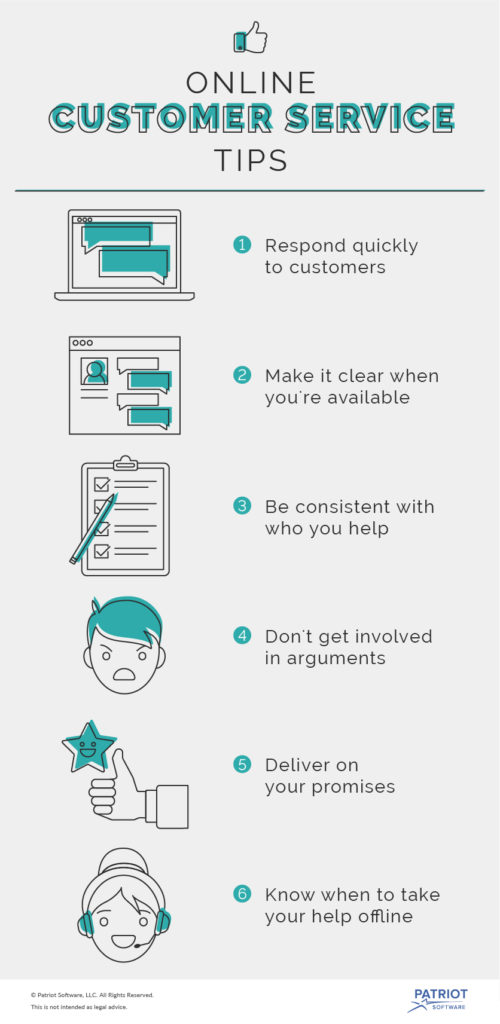Most everything is online today. All information is just fingertips away.
Your customers are online, so your business needs to be online, too. They will look for your business information online. They want to find your products and services, your location, and your hours. And when your customers need help or have a complaint, they’ll take that online, too.
You need to take your small business customer service online. Online customer service isn’t the same as in-person or phone support. You need to focus your efforts to give the best online customer service possible.
Small Business Customer Service Tips
Use these online customer service tips to improve your customer support. There are general online customer support tips, plus specific tips for email, social media, and business websites.

General customer service tips
The online world never stops moving. Even when your business closes for the day, the internet doesn’t turn off. Because of this, customers might try to reach out to you at any time and on any day.
But, you might not be able to respond to customers as soon as they post something. Or, you might not be willing to respond outside of your business hours. Make it easy for customers to know when you are available to answer questions. Make your business hours easy to find so people know when to expect to hear from you.
When you can respond to customers, respond quickly. People expect fast answers online.
Don’t pick and choose who to help. Have consistency. If you normally respond to all comments, don’t skip over some. You will make customers feel neglected, hurting your business image.
However, there might be times when it’s better to ignore customers. For example, if a customer is obviously trying to start an argument, it’s best not to respond. Odds are, they’ll try to make you look like the bad guy in the argument, hurting your business.
Always deliver on your promises. If you tell a customer you’ll replace a faulty item, replace it. Never underdeliver; always overdeliver.
Sometimes customer service will start online, but you can serve the customer better if you take the conversation offline. You might ask the customer to call or come in if there’s a lot of back and forth, you need the customer to answer many questions, or you need personal information that is best not shared online (such as phone numbers, email addresses, and credit card numbers).
Social media customer service
Using social media for customer service is becoming more popular.
Be where your customers are on social media. A market analysis can help you discover which social media sites your current and potential customers already use. Sign up for accounts on those social networks.
Post regular updates about your business on social media. The updates might be about new products or services, answers to common questions, or how you are making changes to improve your business. These updates not only let you do social media marketing, but they also help you be proactive about social media customer service.
Monitor mentions of your business on social media sites. People might be talking about your business even if they don’t post on your page or tag your business in a post. Regularly search for posts that include your business name in the text to see if people have said anything.
Respond to or react to as many customer messages and posts as possible. Sometimes, a simple “Thank you.” or clicking the “like” option is enough.
You should not delete or hide someone’s comment because you don’t like what they said. They might bring attention to their post being removed, which could then give you negative publicity. If possible, respectfully reply or ignore the comment.
Email customer service
Email is a useful way to reach individuals.
Send regular newsletters to your email list. Give them updates about your business, including new offers and improvements. Your newsletter can help your customers stay informed.
When a customer purchases something, send the customer email updates. For example, you might send an initial email to thank the customer for making the purchase, followed by an email with shipping information. The email updates let the customer know where they are in the process of getting their product.
If you let customers contact your business by email, be prompt in responding to the emails. Consider setting an out-of-office response for when your business is closed so people know when to expect an answer.
Business website customer service
Your website is a great place to consolidate your business information. And, it’s a good starting place for online small business customer service.
Like with social media and emails, you can post business news on your website. Regular business updates create an effective website.
Add a customer feedback form to your website. You might put the form on your contact page, or create a separate page.
You can add a FAQ page to your website. This page will let customers help themselves, and will save you time by reducing the number of messages about common questions. For example, you might talk about your return policy on the FAQ page. Direct viewers to an email address, phone number, or form in case they have further questions.
These views are made solely by the author.



